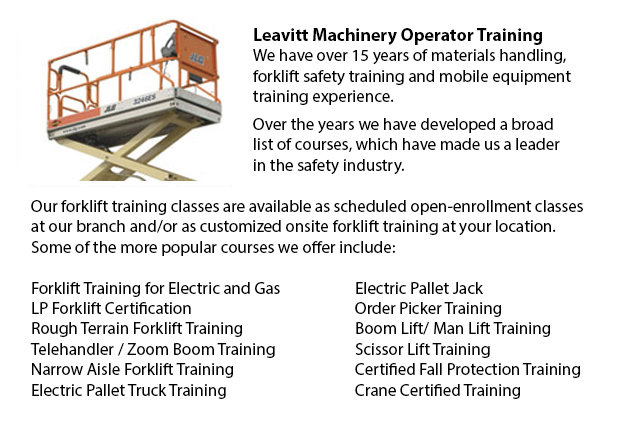
Scissor Lift Certification Vancouver - Numerous worksites and tradespeople such as masons, iron workers and welders use scissor lift platforms in order to help them reach elevated work places. The use of a scissor lift is normally secondary to their trade. Thus, it is vital that all platform operators be trained well and licensed. Regulators, industry and lift manufacturers work together to make certain that operators are trained in safely utilizing work platforms.
Scissor lift work platforms are otherwise referred to as manlifts or AWPs. These work machines are rather easy to use and offer a steady work setting, nonetheless they do have risks because they lift individuals The following are several important safety issues common to AWPs:
In order to protect those working around work platforms from accidental power discharge because of close working proximities to wires and power lines, there is a minimum safe approach distance (likewise referred to as MSAD). Voltage can arc across the air and cause injury to staff on a work platform if MSAD is not observed.
To be able to guarantee maximum stability, caution must be taken when the work platform is lowered. Moving the load towards the turntable, the boom should be retracted. This will help maintain stability in lowering of the platform.
The rules regarding tie offs do not mandate individuals working on a scissor lift to tie themselves off. Some groups would however, need their workers to tie off in their employer guidelines, local regulations or job-specific risk assessment. The manufacturer-provided anchorage is the only safe anchorage wherein harness and lanyard combinations should be connected.
Observe the maximum slope rating and do not go beyond it. A grade could be measured by laying a board or straight edge on the slope. Next, a carpenter's level can be placed on the straight edge and raised until the end is level. By measuring the distance to the ground and dividing the rise by the length of the straight edge, then multiplying by 100, the per cent slope could be determined.
A standard walk-around check should be done to determine if the unit is mechanically safe. A location assessment determines if the work place is safe. This is important specially on changing construction locations because of the risk of obstacles, contact with power lines and unimproved surfaces. A function test should be done. If the unit is utilized correctly and safely and right shutdown measures are followed, the possibilities of accidents are greatly lessened.
-
Telehandler Ticket Vancouver
Telehandler Ticket Vancouver - The telescopic handler or telehandler is a frequently used equipment in agricultural and industrial applications. This equipment is similar in appearance to a forklift and also functions in a similar way, even if teleha... More -
Forklift Operator Certification Vancouver
Forklift Operator Certification Vancouver - Forklift operator certification is usually needed for employees working within industrial, warehouse or construction environments to guarantee the safe operation of forklifts. Workplace training need to fol... More -
Certified Fall Protection Training in Vancouver
There are high numbers of injuries at work linked to falling and a lot of fall-related deaths reported each and every year. The majority of these instances might have been avoided with better training, better measures in place, and by correctly equip... More -
Forklift Training Course Vancouver
Forklift Training Course Vancouver - CSA and OSHA establish criteria for forklift safety training which meets existing standards and regulations. Anyone planning to utilize a forklift is needed to successfully complete safety training prior to using... More -
Overhead Crane Certification Vancouver
Overhead Crane Certification Vancouver - The overhead crane certification course is a program that is designed to assist trainees, even if they have literacy or language restrictions. The course comprises a practical hands-on training session and a c... More -
Forklift Instructor Training Vancouver
Forklift Instructor Training Vancouver - Forklift Instructor training certification is recommended for forklift operators who would like to become instructors. To qualify for forklift instructor training, operators must be able to prove they possess... More -
Crane / Overhead Crane / Truck Mounted Crane / Hydraulic Cranes Training in Vancouver
Overhead cranes are likewise referred to as bridge cranes. They are actually a type of crane which comprises a hook and line apparatus which runs along a horizontal beam which runs along two widely separated rails. Lots of overhead cranes can be foun... More -
Scissor Lift Safety Training Vancouver
Scissor Lift Safety Training Vancouver - A scissor lift is a kind of platform lift that moves vertically. The lift table is moved in a vertical motion because of criss-cross folding supports which are linked in what is referred to as a pantograph. Th... More

Forklift Training Vancouver
TOLL FREE: 1-888-254-6157
24389 Fraser Highway
Langley, British Columbia
forklifttrainingvancouver.com
Email Us
About Us


